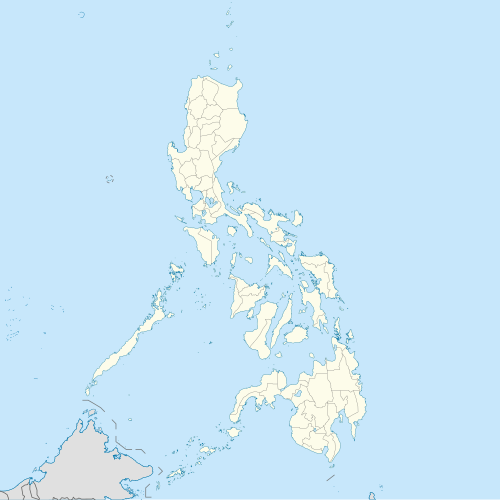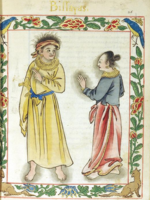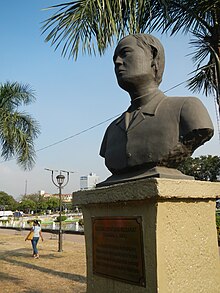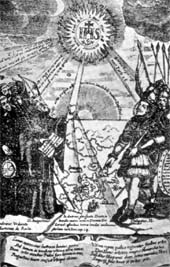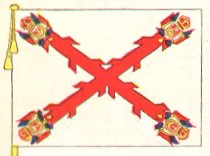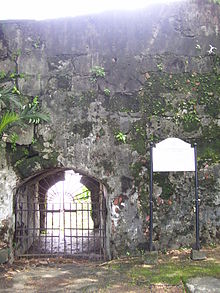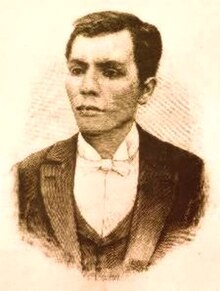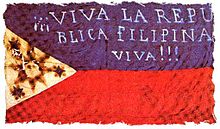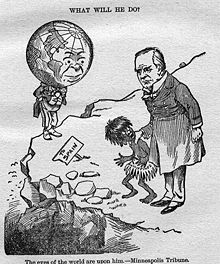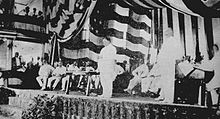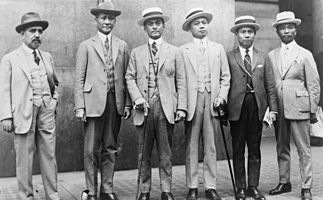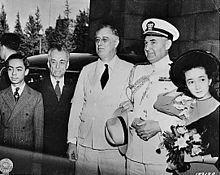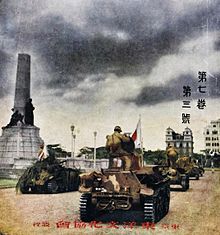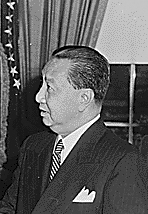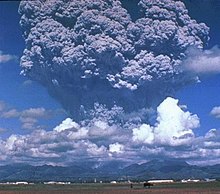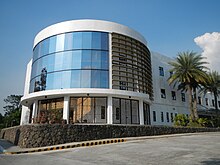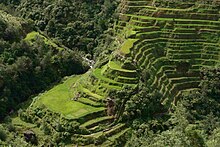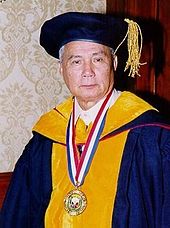The history of the Philippines is believed to have begun with the arrival of the first humans using rafts or boats at least 67,000 years ago as the 2007 discovery of Callao Man suggested. Negrito groups first inhabited the isles. Groups of Austronesians later migrated to the islands.
Scholars generally believe that these social groups eventually developed into various settlements or polities with varying degrees of economic specialization, social stratification, and political organization.[5] Some of these settlements (mostly those located on major river deltas) achieved such a scale of social complexity that some scholars believe they should be considered early states.[6] This includes the predecessors of modern-day population centers such as Maynila, Tondo, Pangasinan, Cebu, Panay, Bohol, Butuan, Cotabato, Lanao, and Sulu[2] as well as some polities, such as Ma-i, whose possibly location are still the subject of debate among scholars.[7]
These polities were either influenced by the Hindu-Buddhist[8] Indian religion, language, culture, literature and philosophy from India through many campaigns from India including the South-East Asia campaign of Rajendra Chola I,[9] Islam from Arabia or were Sinified tributary states allied to China. These small maritime states flourished from the 1st millennium.[10][11] These kingdoms traded with what are now called China, India, Japan, Thailand, Vietnam, and Indonesia.[12] The remainder of the settlements were independent barangays allied with one of the larger states.
The first recorded visit by Europeans is the arrival of Ferdinand Magellan. He sighted Samar Island on March 16, 1521 and landed the next day on Homonhon Island, now part of Guiuan, Eastern Samar.[13] Spanish colonization began with the arrival of Miguel López de Legazpi's expedition on February 13, 1565 from Mexico. He established the first permanent settlement in Cebu.[14] Much of the archipelago came under Spanish rule, creating the first unified political structure known as the Philippines. Spanish colonial rule saw the introduction of Christianity, the code of law and the oldest modern university in Asia. The Philippines was ruled under the Mexico-based Viceroyalty of New Spain. After which, the colony was directly governed by Spain.
Spanish rule ended in 1898 with Spain's defeat in the Spanish–American War. The Philippines then became a territory of the United States. U.S forces suppressed a Philippine Revolution led by Emilio Aguinaldo. The United States established the Insular Government to rule the Philippines. In 1907, the elected Philippine Assembly was set up with popular elections. The U.S. promised independence in the Jones Act.[15] The Philippine Commonwealth was established in 1935, as a 10-year interim step prior to full independence. However, in 1942 during World War II, Japan occupied the Philippines. The U.S. military overpowered the Japanese in 1945. The Treaty of Manila in 1946 established an independent Philippine Republic.
Timeline
Prehistory
Docking station and entrance to the Tabon Cave Complex Site in Palawan, where one of the oldest human remains was located.
Discovery of stone tools and fossils of butchered animal remains in Rizal, Kalinga described in a 2018 article in Nature has pushed back evidence of early hominins in the country to as early as 709,000 years.[16] Still, the earliest archeological evidence for man in the archipelago is the 67,000-year-old Callao Man of Cagayan and the Angono Petroglyphs in Rizal, both of whom appear to suggest the presence of human settlement prior to the arrival of the Negritos and Austronesian speaking people.
There are several opposing theories regarding the origins of ancient Filipinos. F. Landa Jocano theorizes that the ancestors of the Filipinos evolved locally.[citation needed] Wilhelm Solheim's Island Origin Theory[22] postulates that the peopling of the archipelago transpired via trade networks originating in the Sundaland area around 48,000 to 5000 BC rather than by wide-scale migration. The Austronesian Expansion Theory states that Malayo-Polynesians coming from Taiwan began migrating to the Philippines around 4000 BC, displacing earlier arrivals.[23][24]
The Negritos were early settlers, but their appearance in the Philippines has not been reliably dated.[25] They were followed by speakers of the Malayo-Polynesian languages, a branch of the Austronesian language family, who began to arrive in successive waves beginning about 4000 BC, displacing the earlier arrivals.[26][27] Before the expansion out of Taiwan, recent archaeological, linguistic and genetic evidence has linked Austronesian speakers in Insular Southeast Asia to cultures such as the Hemudu, its successor the Liangzhu[28][29] and Dapenkeng in Neolithic China. During this neolithic period, a "jade culture" is said to have existed as evidenced by tens of thousands of exquisitely crafted jade artifacts found in the Philippines dated to 2000 BC.[35][36] The jade is said to have originated nearby in Taiwan and is also found in many other areas in insular and mainland Southeast Asia. These artifacts are said to be evidence of long range communication between prehistoric Southeast Asian societies.[37]
The Ifugao/Igorot people utilized terrace farming in the steep mountainous regions of northern Philippines over 2000 years ago.
By 1000 BC, the inhabitants of the Philippine archipelago had developed into four distinct kinds of peoples: tribal groups, such as the Aetas, Hanunoo, Ilongots and the Mangyan who depended on hunter-gathering and were concentrated in forests; warrior societies, such as the Isneg and Kalinga who practiced social ranking and ritualized warfare and roamed the plains; the petty plutocracy of the Ifugao Cordillera Highlanders, who occupied the mountain ranges of Luzon; and the harbor principalities of the estuarine civilizations that grew along rivers and seashores while participating in trans-island maritime trade.[38] It was also during the first millennium BC that early metallurgy was said to have reached the archipelagos of maritime Southeast Asia via trade with India[39][40]
Around 300–700 AD, the seafaring peoples of the islands traveling in balangays began to trade with the Indianized kingdoms in the Malay Archipelago and the nearby East Asian principalities, adopting influences from both Buddhism and Hinduism.[41][42]
The Jade culture
Metal lingling-o earrings from Luzon.
Existence of a "Jade culture" in the Philippines is evidenced by tens of thousands of exquisitely crafted jade artifacts found at a site in Batangas province.[35][36]
Jade artifacts are made from white and green nephrite and dating as far back as 2000–1500 BC, have been discovered at a number of archeological excavations in the Philippines since the 1930s. The artifacts have been both tools like adzes[43] and chisels, and ornaments such as lingling-o earrings, bracelets and beads.
Nephrite, otherwise known as Jade, is a mineral widely used throughout Asia as ornaments or for decorative purposes. The oldest jade artefacts in Asia (6000 BC) were found in China where they were used as the primary hardstone of Chinese sculpturing. In 3000 BC, jade production in the Hongsan and Liangzhu cultures of China reached its peak. During this period, the knowledge of jade craftsmanship spread across the sea to Taiwan and eventually to the Philippines. The artefacts discovered in several sites in the Philippines were made from nephrite. Nephrite excavated in the Philippines were of two types: white nephrite and green nephrite.[44]
The Sa Sa Huỳnh Culture
Asia in 200 BC, showing Sa Huỳnh cultures in southeast Asia
The Sa Huỳnh culture centred on present-day Vietnam, showed evidence of an extensive trade network. Sa Huỳnh beads were made from glass, carnelian, agate, olivine, zircon, gold and garnet; most of these materials were not local to the region, and were most likely imported. Han dynasty-style bronze mirrors were also found in Sa Sa Huỳnh sites.
Conversely, Sa Sa Huỳnh produced ear ornaments have been found in archaeological sites in Central Thailand, Taiwan (Orchid Island), and in the Philippines, in the Palawan, Tabon Caves. One of the great examples is the Kalanay Cave in Masbate; the artefacts on the site in one of the "Sa Huyun-Kalanay" pottery complex sites were dated 400BC–1500 AD. The Maitum Anthropomorphic Pottery in the Sarangani Province of southern Mindanao is c. 200 AD.[45][46]
Timeline of Iron age
Dates are approximate, consult particular article for details
Prehistoric (or Proto-historic) Iron Age Historic Iron Age
Pre-colonial period (900 AD to 1565)
Initial recorded history
Piloncitos, a type of gold nugget with Baybayin Ma characters. Used as one of the early currencies along with gold rings
During the period of the south Indian Pallava dynasty and the north Indian Gupta Empire, Indian culture spread to Southeast Asia and the Philippines which led to the establishment of Indianized kingdoms.[47][48] The end of Philippine prehistory is 900,[49] the date inscribed in the oldest Philippine document found so far, the Laguna Copperplate Inscription. From the details of the document, written in Kawi script, the bearer of a debt, Namwaran, along with his children Lady Angkatan and Bukah, are cleared of a debt by the ruler of Tondo. From the various Sanskrit terms and titles seen in the document, the culture and society of Manila Bay was that of a Hindu–Old Malay amalgamation, similar to the cultures of Java, Peninsular Malaysia and Sumatra at the time.
There are no other significant documents from this period of pre-Hispanic Philippine society and culture until the Doctrina Christiana of the late 16th century, written at the start of the Spanish period in both native Baybayin script and Spanish. Other artifacts with Kawi script and baybayin were found, such as an Ivory seal from Butuan dated to the early 11th century[50] and the Calatagan pot with baybayin inscription, dated to the 13th century.[51]
In the years leading up to 1000, there were already several maritime societies existing in the islands but there was no unifying political state encompassing the entire Philippine archipelago. Instead, the region was dotted by numerous semi-autonomous barangays (settlements ranging in size from villages to city-states) under the sovereignty of competing thalassocracies ruled by datus, wangs, rajahs, sultans or lakans.[52] or by upland agricultural societies ruled by "petty plutocrats". States such as the Kingdom of Maynila, the Kingdom of Taytay in Palawan (mentioned by Antonio Pigafetta to be where they resupplied when the remaining ships escaped Cebu after Magellan was slain), the Chieftaincy of Coron Island ruled by fierce warriors called Tagbanua as reported by Spanish missionaries mentioned by Nilo S. Ocampo,[53] Namayan, the Kingdom of Tondo, the Sinitic wangdom of Pangasinan, the nation of Ma-i, the Kedatuans of Madja-as and Dapitan, the Indianized rajahnates of Butuan and Cebu and the sultanates of Maguindanao, Lanao and Sulu existed alongside the highland societies of the Ifugao and Mangyan.[54][55][56][57] Some of these regions were part of the Malayan empires of Srivijaya, Majapahit and Brunei.[58][59][60]
The Polity of Tondo
Since at least the year 900, this thalassocracy centered in Manila Bay flourished via an active trade with Chinese, Japanese, Malays, and various other peoples in Asia. Tondo thrived as the capital and the seat of power of this ancient kingdom, which was led by kings under the title "Lakan" which belongs to the caste of the Maharlika, who were the feudal warrior class in ancient Tagalog society. They ruled a large part of what is now known as Luzon from Ilocos to Bicol from possibly before 900 AD to 1571, becoming the largest pre-colonial Philippine state. The Spaniards called them Hidalgos.The people of Tondo had developed a culture which is predominantly Hindu and Buddhist, they were also good agriculturists, and lived through farming and aquaculture. During its existence, it grew to become one of the most prominent and wealthy kingdom states in pre-colonial Philippines due to heavy trade and connections with several neighboring nations such as China and Japan.
The Laguna Copperplate Inscription, c. 900 CE. The oldest known historical record found in the Philippines, which indirectly refers to the polity of Tondo
Due to its very good relations with Japan, the Japanese called Tondo as Luzon, even a famous Japanese merchant, Luzon Sukezaemon, went as far as to change his surname from Naya to Luzon. In 900 AD, the lord-minister Jayadewa presented a document of debt forgiveness to Lady Angkatan and her brother Bukah, the children of Namwaran. This is described in the Philippines' oldest known document, the Laguna Copperplate Inscription.[63]
Caboloan (Pangasinan)
Pangasinan or Feng-chia-hsi-lan in Chinese records, was a sovereign Prehispanic Philippine state, notable for having traded with the Kingdom of Ryukyu, Japan and was a tributary state to Ming Dynasty. The Chinese records of this kingdom began when the first tributary King (Wang in Chinese), Kamayin, sent an envoy offering gifts to the Chinese Emperor.[64] The state occupies the current province of Pangasinan. It was locally known the Luyag na Kaboloan (also spelled Caboloan), with Binalatongan as its capital, existed in the fertile Agno River valley. It flourished around the same period, the Srivijaya and Majapahit empires arose in Indonesia which had extended their influence to much of the Malay Archipelago. Urduja, a legendary woman warrior, is believed to have ruled in Pangasinan around the 14th century. The Luyag na Kaboloan expanded the territory and influence of Pangasinan to what are now the neighboring provinces of Zambales, La Union, Tarlac, Benguet, Nueva Ecija, and Nueva Vizcaya. Pangasinan enjoyed full independence until the Spanish conquest.In the sixteenth century Pangasinan was called the "Port of Japan" by the Spanish. The locals wore native apparel typical of other maritime Southeast Asian ethnic groups in addition to Japanese and Chinese silks. Even common people were clad in Chinese and Japanese cotton garments. They also blackened their teeth and were disgusted by the white teeth of foreigners, which were likened to that of animals. Also, used porcelain jars typical of Japanese and Chinese households. Japanese-style gunpowder weapons were also encountered in naval battles in the area.[1] In exchange for these goods, traders from all over Asia would come to trade primarily for gold and slaves, but also for deerskins, civet and other local products. Other than a notably more extensive trade network with Japan and China, they were culturally similar to other Luzon groups to the south.
The Nation of Ma-i
Around 1225, the nation of Ma-i, a pre-Hispanic Philippine island-state centered in Mindoro,[65] flourished as an entrepôt, attracting traders and shipping from the Kingdom of Ryukyu to the Empire of Japan.[66] Chao Jukua, a customs inspector in Fukien province, China wrote the Zhufan Zhi ("Description of the Barbarous Peoples"[67]), which described trade with this pre-colonial Philippine state. Its people were noted for their honesty and trustworthiness in trade.[68]The Kedatuan of Madja-as
During the 11th century several exiled datus of the collapsing empire of Srivijaya[69] led by Datu Puti led a mass migration to the central islands of the Philippines, fleeing from Rajah Makatunao of the island of Borneo. Upon reaching the island of Panay and purchasing the island from Negrito chieftain Marikudo, they established a confederation of polities and named it the Kedatuan of Madja-as centered in Aklan and they settled the surrounding islands of the Visayas. This confederation reached its peak under Datu Padojinog. During his reign the confederations' hegemony extended over most of the islands of Visayas. Its people consistently made piratical attacks against Chinese imperial shipping.[70]
The Rajahnate of Cebu
Trading at Port of Sugbu,
Chinese, Anamese, Cambodian, Europeans and Arabs entered and traded at
the Cebu Port. Gold, cotton, and slaves were bartered in exchange of
silk, porcelain, beads, and other metals. Traders paid tribute to the
Rajah of Cebu.
The Rajahnate of Cebu was a classical Philippine state which used to exist on Cebu island prior to the arrival of the Spanish. It was founded by Sri Lumay otherwise known as Rajamuda Lumaya, a minor prince of the Hindu Chola dynasty which happened to occupy Sumatra-Indonesia. He was sent by the maharajah to establish a base for expeditionary forces to subdue the local kingdoms but he rebelled and established his own independent Rajahnate instead. This rajahnate warred against the 'magalos' (Slave traders) of Maguindanao and had an alliance with the Rajahnate of Butuan and Indianized Kutai in South Borneo, before it was weakened by the insurrection of Datu Lapu-Lapu.[71]
The Rajahnate of Butuan
By year 1011, Rajah Sri Bata Shaja, the monarch of the Indianized Rajahnate of Butuan, a maritime-state famous for its goldwork[72] sent a trade envoy under ambassador Likan-shieh to the Chinese Imperial Court demanding equal diplomatic status with other states.[73] The request being approved, it opened up direct commercial links with the Rajahnate of Butuan and the Chinese Empire thereby diminishing the monopoly on Chinese trade previously enjoyed by their rivals, Tondo and the Champa civilization.[74] Evidence of the existence of this rajahnate is given by the Butuan Silver Paleograph.[75]The Sultanate of Sulu
The official flag of the Royal Sultanate of Sulu under the guidance of Ampun Sultan Muedzul Lail Tan Kiram of Sulu.
In 1380, Karim ul' Makdum and Shari'ful Hashem Syed Abu Bakr, an Arab trader born in Johore, arrived in Sulu from Malacca and established the Sultanate of Sulu by converting its previous ruler, the Hindu king, Rajah Baguinda, to Islam and then marrying his daughter. This sultanate eventually gained great wealth due to its diving for fine pearls.[76]
The Sultanate of Maguindanao
The bust of Sultan Muhammad Kudarat of Maguindanao at Rizal Park.
The Sultanate of Maguindanao rose to prominence at the end of the 15th century, Shariff Mohammed Kabungsuwan of Johor introduced Islam in the island of Mindanao and he subsequently married Paramisuli, an Iranun Princess
from Mindanao, and established the Sultanate of Maguindanao.[77] It ruled most parts of Mindanao and continued to exist prior to the Spanish colonization until the 19th century. The Sultanate also traded and maintained good relations with the Chinese, Dutch, and the British.[78][79]
The Sultanate of Lanao
The Sultanates of Lanao in Mindanao, Philippines were founded in the 16th century through the influence of Shariff Kabungsuan, who was enthroned as first Sultan of Maguindanao in 1520. Islam was introduced to the area by Muslim missionaries and traders from the Middle East, Indian and Malay regions who propagated Islam to Sulu and Maguindanao. Unlike in Sulu and Maguindanao, the Sultanate system in Lanao was uniquely decentralized. The area was divided into Four Principalities of Lanao or the Pat a Pangampong a Ranao which are composed of a number of royal houses (Sapolo ago Nem a Panoroganan or The Sixteen (16) Royal Houses) with specific territorial jurisdictions within mainland Mindanao. This decentralized structure of royal power in Lanao was adopted by the founders, and maintained up to the present day, in recognition of the shared power and prestige of the ruling clans in the area, emphasizing the values of unity of the nation (kaiisaisa o bangsa), patronage (kaseselai) and fraternity (kapapagaria). By the 16th century, Islam had spread to other parts of the Visayas and Luzon.The Bruneian Empire and the expansion of Islam
Prior to the usage of the Arabic style merged with Modernist style common in mosque architecture in the Philippines today, the mosques of the Philippines used to be the vernacular hut-style and Pagoda-style, which were common until the late 19th century.
During the reign of Sultan Bolkiah in 1485 to 1521, the Islamized Bruneian Empire decided to break the Dynasty of Tondo's monopoly in the China trade by attacking Tondo and defeating Rajah Gambang and then establishing the State of Selurong (Kingdom of Maynila) as a Bruneian satellite-state.[3][80] A new dynasty under the Islamized Rajah Salalila[81] was also established to challenge the House of Lakandula in Tondo.[82] In addition to establishing the satellite state of Manila, Sultan Bolkiah also married Laila Mecana, the daughter of Sulu Sultan Amir Ul-Ombra to expand Brunei's influence in both Luzon and Mindanao. Furthermore, Islam was further strengthened by the arrival to the Philippines of traders and proselytizers from Malaysia and Indonesia.[83]
Concurrent with the spread of Islam in the Philippine archipelago, was the rise of the Lucoes who were the people of Luzon. They rose to prominence by participating in trading ventures and military campaigns in Myanmar, Malacca and East Timor[84][85][86] where they were employed as traders and mercenaries.[87][88][89]
Around 1563 AD, at the closing stages of the precolonial era, the Kedatuan of Dapitan in Bohol achieved prominence and it was known to a later Spanish missionary, Alcina, as the "Venice of the Visayas", because it was a wealthy, wooden and floating city-state in the Visayas. However, this kedatuan was eventually attacked and destroyed by soldiers from the Sultanate of Ternate, a state made up of Muslim Papuan people. The survivors of the destruction, led by their datu, Pagbuaya, migrated to northern Mindanao and established a new Dapitan there. Eventually, in vengeance against the Muslims and Portuguese allied to the Ternateans, they aided the Spanish in the conquest of Muslim Manila and in the Spanish expeditions to capture Portuguese Ternate. There was also a simmering territorial conflict between the Polity of Tondo and the Bruneian vassal-state, the Islamic Rajahnate of Maynila, to which the ruler of Maynila, Rajah Matanda, sought military assistance against Tondo from his relatives at the Sultanate of Brunei.[90] The Hindu Rajahnates of Butuan and Cebu also endured slave raids from, and waged wars against the Sultanate of Maguindanao.[91] Simultaneous with these slave-raids, was the rebellion of Datu Lapu-Lapu of Mactan against Rajah Humabon of Cebu.[92] The sparse population and the multiple states competing over the limited territory and people of the islands simplified Spanish colonization by allowing its conquistadors to effectively employ a strategy of divide and conquer for rapid conquest.
Spanish settlement and rule (1565–1898)
Early Spanish expeditions and conquests
Ferdinand Magellan arrived in the Philippines in 1521.
Parts of the Philippine Islands were known to Europeans before the 1521 Spanish expedition around the world led by Portuguese-born Spanish explorer Ferdinand Magellan (the Portuguese conquered Malacca City in 1511 and reached Maluku Islands in 1512 ). Magellan landed on the island called Homonhon, claiming the islands he saw for Spain, and naming them Islas de San Lázaro.[93] He established friendly relations with some of the local leaders especially with Rajah Humabon and converted some of them to Roman Catholicism.[93] In the Philippines, they explored many islands including the island of Mactan. However, Magellan was killed during the Battle of Mactan against the local datu, Lapu-Lapu.
Old Spanish Chart of the Philippine Islands
Over the next several decades, other Spanish expeditions were dispatched to the islands. In 1543, Ruy López de Villalobos led an expedition to the islands and gave the name Las Islas Filipinas (after Philip II of Spain) to the islands of Samar and Leyte.[94] The name was then extended to the entire archipelago later on in the Spanish era.
A late 17th-century manuscript by Gaspar de San Agustin from the Archive of the Indies, depicting López de Legazpi's conquest of the Philippines
European colonization began in earnest when Spanish explorer Miguel López de Legazpi arrived from Mexico in 1565 and formed the first European settlements in Cebu. Beginning with just five ships and five hundred men accompanied by Augustinian monks, and further strengthened in 1567 by two hundred soldiers, he was able to repel the Portuguese and create the foundations for the colonization of the Archipelago. In 1571, the Spanish, their Latin-American recruits and their Visayan allies attacked and occupied the kingdom of Tondo as well as Maynila, a vassal-state of the Brunei Sultanate, establishing Manila as the capital of the Spanish East Indies.
Legazpi built a fort in Maynila and made overtures of friendship to Lakan Dula, Lakan of Tondo, who accepted. However, Maynila's former ruler, the Muslim rajah, Rajah Sulayman, who was a vassal to the Sultan of Brunei, refused to submit to Legazpi, but failed to get the support of Lakan Dula or of the Pampangan and Pangasinan settlements to the north. When Tarik Sulayman and a force of Kapampangan and Tagalog Muslim warriors attacked the Spaniards in the battle of Bankusay, he was finally defeated and killed.
In 1578, the Castilian War erupted between the Christian Spaniards and Muslim Bruneians over control of the Philippine archipelago. On one side, the newly Christianized Non-Muslim Visayans of the Kedatuan of Madja-as and Rajahnate of Cebu, plus the Rajahnate of Butuan (which were from northern Mindanao), as well as the remnants of the Kedatuan of Dapitan had previously waged war against the Sultanate of Sulu and Kingdom of Maynila, then joined the Spanish in the war against the Bruneian Empire and its allies, the Bruneian puppet-state of Maynila and Sulu which had dynastic links with Brunei. The Spanish and its Visayan allies assaulted Brunei and seized its capital, Kota Batu. This was achieved as a result in part of the assistance rendered to them by two noblemen, Pengiran Seri Lela and Pengiran Seri Ratna. The former had traveled to Manila to offer Brunei as a tributary of Spain for help to recover the throne usurped by his brother, Saiful Rijal.[97] The Spanish agreed that if they succeeded in conquering Brunei, Pengiran Seri Lela would indeed become the Sultan, while Pengiran Seri Ratna would be the new Bendahara. In March 1578, the Spanish fleet, led by De Sande himself, acting as Capitán General, started their journey towards Brunei. The expedition consisted of 400 Spaniards, 1,500 Filipino natives and 300 Borneans.[98] The campaign was one of many, which also included action in Mindanao and Sulu.
The Spanish succeeded in invading the capital on April 16, 1578, with the help of Pengiran Seri Lela and Pengiran Seri Ratna. Sultan Saiful Rijal and Paduka Seri Begawan Sultan Abdul Kahar were forced to flee to Meragang then to Jerudong. In Jerudong, they made plans to chase the conquering army away from Brunei. The Spanish suffered heavy losses due to a cholera or dysentery outbreak.[101][102] They were so weakened by the illness that they decided to abandon Brunei to return to Manila on June 26, 1578, after just 72 days. Before doing so, they burned the mosque, a high structure with a five-tier roof.[103]
Pengiran Seri Lela died in August–September 1578, probably from the same illness that had afflicted his Spanish allies, although there was suspicion he could have been poisoned by the ruling Sultan. Seri Lela's daughter, the Bruneian princess, left with the Spanish and went on to marry a Christian Tagalog, named Agustín de Legazpi of Tondo and had children in the Philippines.[104]
In 1587, Magat Salamat, one of the children of Lakan Dula, along with Lakan Dula's nephew and lords of the neighboring areas of Tondo, Pandacan, Marikina, Candaba, Navotas and Bulacan, were executed when the Tondo Conspiracy of 1587–1588 failed[105] in which a planned grand alliance with the Japanese Christian-captain, Gayo, and Brunei's Sultan, would have restored the old aristocracy. Its failure resulted in the hanging of Agustín de Legaspi and the execution of Magat Salamat (the crown-prince of Tondo).[106] Thereafter, some of the conspirators were exiled to Guam or Guerrero, Mexico.
Spanish power was further consolidated after Miguel López de Legazpi's complete assimilation of Madja-as, his subjugation of Rajah Tupas, the Rajah of Cebu and Juan de Salcedo's conquest of the provinces of Zambales, La Union, Ilocos, the coast of Cagayan, and the ransacking of the Chinese warlord Limahong's pirate kingdom in Pangasinan.
The Spanish also invaded Northern Taiwan and Ternate in Indonesia, using Filipino warriors, before they were driven out by the Dutch.[107]
The Spanish and the Moros of the sultanates of Maguindanao, Lanao and Sulu also waged many wars over hundreds of years in the Spanish-Moro conflict, not until the 19th century did Spain succeed in defeating the Sulu Sultanate and taking Mindanao under nominal suzerainty.
The Spanish considered their war with the Muslims in Southeast Asia an extension of the Reconquista, a centuries-long campaign to retake and rechristianize the Spanish homeland which was invaded by the Muslims of the Umayyad Caliphate. The Spanish expeditions into the Philippines were also part of a larger Ibero-Islamic world conflict[108] that included a rivalry with the Ottoman Caliphate which had a center of operations at its nearby vassal, the Sultanate of Aceh.[109]
Spanish settlement during the 16th and 17th centuries
The sketch of the Plaza de Roma Manila by Fernando Brambila, a member of the Malaspina Expedition during their stop in Manila in 1792.
Bahay na bato, a typical Filipino urban house during the colonial era
The "Memoria de las Encomiendas en las Islas" of 1591, just twenty years after the conquest of Luzon, reveals a remarkable progress in the work of colonization and the spread of Christianity.[110] A cathedral was built in the city of Manila with an episcopal palace, Augustinian, Dominican and Franciscan monasteries and a Jesuit house. The king maintained a hospital for the Spanish settlers and there was another hospital for the natives run by the Franciscans. In order to defend the settlements the Spaniards established in the Philippines, a network of military fortresses called "Presidios" were constructed and officered by the Spaniards, and sentried by Latin-Americans and Filipinos, across the archipelago, to protect it from foreign nations such as the Portuguese, British and Dutch as well as raiding Muslims and Wokou.[111] The Manila garrison was composed of roughly four hundred Spanish soldiers and the area of Intramuros as well as its surroundings, were initially settled by 1200 Spanish families.[112] In Cebu City, at the Visayas, the settlement received a total of 2,100 soldier-settlers from New Spain.[113] At the immediate south of Manila, Mexicans were present at Ermita[114] and at Cavite[115][116][117] where they were stationed as sentries. In addition, men conscripted from Peru, were also sent to settle Zamboanga City in Mindanao, to wage war upon Muslim pirates.[118] There were also communities of Spanish-Mestizos that developed in Iloilo,[119] Negros[120] and Vigan.[121] Interactions between native Filipinos and immigrant Spaniards, Latin-Americans and their Spanish-Mestizo descendants eventually caused the formation of a new language, Chavacano, a creole of Mexican Spanish. Meanwhile, in the suburb of Tondo, there was a convent run by Franciscan friars and another by the Dominicans that offered Christian education to the Chinese converted to Christianity. The same report reveals that in and around Manila were collected 9,410 tributes, indicating a population of about 30,640 who were under the instruction of thirteen missionaries (ministers of doctrine), apart from the monks in monasteries. In the former province of Pampanga the population estimate was 74,700 and 28 missionaries. In Pangasinan 2,400 people with eight missionaries. In Cagayan and islands Babuyanes 96,000 people but no missionaries. In La Laguna 48,400 people with 27 missionaries. In Bicol and Camarines Catanduanes islands 86,640 people with fifteen missionaries. Based on the tribute counts, the total founding population of Spanish-Philippines was 667,612 people,[122] of which: 20,000 were Chinese migrant traders,[123] 16,500 were Latino soldier-colonists sent from Peru and Mexico,[124] 3,000 were Japanese residents,[125] and 600 were pure Spaniards from Europe,[126] there was also a large but unknown number of Indian Filipinos, the rest were Malays and Negritos. They were under the care of 140 missionaries, of which 79 were Augustinians, nine Dominicans and 42 Franciscans.[127]
The fragmented and sparsely populated[128] nature of the islands made it easy for Spanish colonization. The Spanish then brought political unification to most of the Philippine archipelago via the conquest of the various small maritime states although they were unable to fully incorporate parts of the sultanates of Mindanao and the areas where the ethnic groups and highland plutocracy of the animist Ifugao of Northern Luzon were established. The Spanish introduced elements of western civilization such as the code of law, western printing and the Gregorian calendar alongside new food resources such as maize, pineapple and chocolate from Latin America.[129]
Plaza Santo Tomas in Intramuros, Manila; where the Santo Domingo Church, Colegio de Santa Rosa and the original University of Santo Tomas were built during the Spanish era.
Education played a major role in the socio-economic transformation of the archipelago. The oldest universities, colleges, and vocational schools and the first modern public education system in Asia were all created during the Spanish colonial period, and by the time Spain was replaced by the United States as the colonial power, Filipinos were among the most educated subjects in all of Asia.[130] The Jesuits founded the Colegio de Manila in 1590, which later became the Universidad de San Ignacio, a royal and pontifical university. They also founded the Colegio de San Ildefonso on August 1, 1595. After the expulsion of the Society of Jesus in 1768, the management of the Jesuit schools passed to other parties. On April 28, 1611, through the initiative of Bishop Miguel de Benavides, the University of Santo Tomas was founded in Manila. The Jesuits also founded the Colegio de San José (1601) and took over the Escuela Municipal, later to be called the Ateneo de Manila University (1859). All institutions offered courses included not only religious topics but also science subjects such as physics, chemistry, natural history and mathematics. The University of Santo Tomás, for example, started by teaching theology, philosophy and humanities and during the 18th century, the Faculty of Jurisprudence and Canonical Law, together with the schools of medicine and pharmacy were opened.
Outside the tertiary institutions, the efforts of missionaries were in no way limited to religious instruction but also geared towards promoting social and economic advancement of the islands. They cultivated into the natives their innate[citation needed] taste for music and taught Spanish language to children.[131] They also introduced advances in rice agriculture, brought from America maize and cocoa and developed the farming of indigo, coffee and sugar cane. The only commercial plant introduced by a government agency was the plant of tobacco. Church and state were inseparably linked in Spanish policy, with the state assuming responsibility for religious establishments.[132] One of Spain's objectives in colonizing the Philippines was the conversion of the local population to Roman Catholicism. The work of conversion was facilitated by the disunity and insignificance of other organized religions, except for Islam, which was still predominant in the southwest.[132] The pageantry of the church had a wide appeal, reinforced by the incorporation of indigenous social customs into religious observances. The eventual outcome was a new Roman Catholic majority, from which the Muslims of western Mindanao and the upland tribal and animistic peoples of Luzon remained detached and alienated from (Ethnic groups such as the Ifugaos of the Cordillera region and the Mangyans of Mindoro).
At the lower levels of administration, the Spanish built on traditional village organization by co-opting local leaders. This system of indirect rule helped create an indigenous upper class, called the principalía, who had local wealth, high status, and other privileges. This perpetuated an oligarchic system of local control. Among the most significant changes under Spanish rule was that the indigenous idea of communal use and ownership of land was replaced with the concept of private ownership and the conferring of titles on members of the principalía.[132]
Around 1608 William Adams, an English navigator contacted the interim governor of the Philippines, Rodrigo de Vivero y Velasco on behalf of Tokugawa Ieyasu, who wished to establish direct trade contacts with New Spain. Friendly letters were exchanged, officially starting relations between Japan and New Spain. From 1565 to 1821, the Philippines was governed as a territory of the Viceroyalty of New Spain from Mexico, via the Royal Audiencia of Manila, and administered directly from Spain from 1821 after the Mexican revolution,[133] until 1898.
The Manila galleons which linked Manila to Acapulco traveled once or twice a year between the 16th and 19th centuries. The Spanish military fought off various indigenous revolts and several external colonial challenges, especially from the British, Chinese pirates, Dutch, and Portuguese. Roman Catholic missionaries converted most of the lowland inhabitants to Christianity and founded schools, universities, and hospitals. In 1863 a Spanish decree introduced education, establishing public schooling in Spanish.[134]
Coat of arms of Manila were at the corners of the Cross of Burgundy in the Spanish-Filipino battle standard.
In 1646, a series of five naval actions known as the Battles of La Naval de Manila was fought between the forces of Spain and the Dutch Republic, as part of the Eighty Years' War. Although the Spanish forces consisted of just two Manila galleons and a galley with crews composed mainly of Filipino volunteers, against three separate Dutch squadrons, totaling eighteen ships, the Dutch squadrons were severely defeated in all fronts by the Spanish-Filipino forces, forcing the Dutch to abandon their plans for an invasion of the Philippines.
Spanish rule during the 18th century
Colonial income derived mainly from entrepôt trade: The Manila Galleons sailing from the port of Manila to the port of Acapulco on the west coast of Mexico brought shipments of silver bullion, and minted coin that were exchanged for return cargoes of Asian, and Pacific products. A total of 110 Manila galleons set sail in the 250 years of the Manila-Acapulco galleon trade (1565 to 1815). There was no direct trade with Spain until 1766.[132]
Fort
Santiago Postern of Our Lady of Solitude, Manila, through which on 5
October 1762, Lieutenant Governor Simón de Anda y Salazar escaped the
British bombardment during the conquest of Manila.
The Philippines was never profitable as a colony during Spanish rule, and the long war against the Dutch in the 17th century together with the intermittent conflict with the Muslims in the South nearly bankrupted the colonial treasury.[132] The Royal Fiscal of Manila wrote a letter to King Charles III of Spain, in which he advises to abandon the colony.
The Philippines survived on an annual subsidy paid by the Spanish Crown, and the 200-year-old fortifications at Manila had not been improved much since first built by the early Spanish colonizers.[135] This was one of the circumstances that made possible the brief British occupation of Manila between 1762 and 1764.
British invasion (1762–1764)
Britain declared war against Spain on January 4, 1762 and on September 24, 1762 a force of British Army regulars and British East India Company soldiers, supported by the ships and men of the East Indies Squadron of the British Royal Navy, sailed into Manila Bay from Madras, India.[136] Manila was besieged and fell to the British on October 4, 1762.Outside of Manila, the Spanish leader Simón de Anda y Salazar organized a militia of 10 000 of mostly from Pampanga to resist British rule. Anda y Salazar established his headquarters first in Bulacan, then in Bacolor.[137] After a number of skirmishes and failed attempts to support uprisings, the British command admitted to the War Secretary in London that the Spanish were "in full possession of the country".[138] The occupation of Manila ended in April 1764 as agreed to in the peace negotiations for the Seven Years' War in Europe. The Spanish then persecuted the Binondo Chinese community for its role in aiding the British.[139] An unknown number of Indian soldiers known as sepoys, who came with the British, deserted and settled in nearby Cainta, Rizal, which explains the uniquely Indian features of generations of Cainta residents.[140]
Spanish rule in the second part of the 18th century
The Cross of Burgundy served as the flag of the Viceroyalty of New Spain (1535–1821)
Colonial houses of the Philippines
In 1766 direct communication was established with Spain and trade with Europe through a national ship based on Spain. Those expeditions were administered since 1785 by the Real Compañía Filipina, which was granted a monopoly of trade between Spain and the islands that lasted until 1834, when the company was terminated by the Spanish crown due to poor management and financial losses.[citation needed]
In 1781, Governor-General José Basco y Vargas established the Economic Society of the Friends of the Country.[141] The Philippines was administered from the Viceroyalty of New Spain until the independence to Mexico in 1821 necessitated the direct rule from Spain of the Philippines from that year.
Spanish rule during the 19th century
The Philippines was included in the vast territory of the Kingdom of Spain, in the first constitution of Spain promulgated in Cadiz in 1812. It was never a colony as modern-day historical literature would say, but an overseas region in Asia {Spanish Constitution 1812}. The Spanish Constitution of 1870 provides for the first autonomous community for "Archipelago Filipino" where all provinces in the Philippine Islands will be given the semi-independent home rule program.
During the 19th century Spain invested heavily in education and infrastructure. Through the Education Decree of December 20, 1863, Queen Isabella II of Spain decreed the establishment of a free public school system that used Spanish as the language of instruction, leading to increasing numbers of educated Filipinos.[142] Additionally, the opening of the Suez Canal in 1869 cut travel time to Spain, which facilitated the rise of the ilustrados, an enlightened class of Spanish-Filipinos that had been able to enroll in Spanish and European universities. The Philippines has contributed one Prime Minister to Spain, Marcelo Azcarraga, who was born in the Bicol Peninsula in the Philippine Islands, Spain.
A great number of infrastructure projects were undertaken during the 19th century that put the Philippine economy and standard of living ahead of most of its Asian neighbors and even many European countries at that time. Among them were a railway system for Luzon, a tramcar network for Manila, and Asia's first steel suspension bridge Puente Claveria, later called Puente Colgante.[143]
On August 1, 1851 the Banco Español-Filipino de Isabel II was established to attend the needs of the rapid economic boom, that had greatly increased its pace since the 1800s as a result of a new economy based on a rational exploitation of the agricultural resources of the islands. The increase in textile fiber crops such as abacá, oil products derived from the coconut, indigo, that was growing in demand, etc., generated an increase in money supply that led to the creation of the bank. Banco Español-Filipino was also granted the power to print a Philippine-specific currency (the Philippine peso) for the first time (before 1851, many currencies were used, mostly the pieces of eight).
Spanish Manila was seen in the 19th century as a model of colonial governance that effectively put the interests of the original inhabitants of the islands before those of the colonial power. As John Crawfurd put it in its History of the Indian Archipelago, in all of Asia the "Philippines alone did improve in civilization, wealth, and populousness under the colonial rule" of a foreign power.[144] John Bowring, Governor General of British Hong Kong from 1856 to 1860, wrote after his trip to Manila:
Escolta, Manila in 1899
"Credit is certainly due to Spain for having bettered the condition of a people who, though comparatively highly civilized, yet being continually distracted by petty wars, had sunk into a disordered and uncultivated state.In The Inhabitants of the Philippines, Frederick Henry Sawyer wrote:
The inhabitants of these beautiful Islands upon the whole, may well be considered to have lived as comfortably during the last hundred years, protected from all external enemies and governed by mild laws vis-a-vis those from any other tropical country under native or European sway, owing in some measure, to the frequently discussed peculiar (Spanish) circumstances which protect the interests of the natives."[145]
Santa Lucia Gate, Intramuros, Manila
"Until an inept bureaucracy was substituted for the old paternal rule, and the revenue quadrupled by increased taxation, the Filipinos were as happy a community as could be found in any colony. The population greatly multiplied; they lived in competence, if not in affluence; cultivation was extended, and the exports steadily increased. [...] Let us be just; what British, French, or Dutch colony, populated by natives can compare with the Philippines as they were until 1895?."[146]The first official census in the Philippines was carried out in 1878. The colony's population as of December 31, 1877, was recorded at 5,567,685 persons.[147] This was followed by the 1887 census that yielded a count of 6,984,727,[148] while that of 1898 yielded 7,832,719 inhabitants.[149]
The estimated GDP per capita for the Philippines in 1900, the year Spain left, was $1,033.00. That made it the second-richest place in all of Asia, just a little behind Japan ($1,135.00), and far ahead of China ($652.00) and India ($625.00).[150]
In 2006, the Civil Code of Spain provided that the acquisition of nationalities of Ibero-American countries, Andorra, the Philippines, Equatorial Guinea, Portugal and those of the Sephardic Jews originally from Spain, does not bear the loss of their Spanish nationalities of origin that paved the way for easier route of Spanish Nationality reacquisition by the people of the Philippines. A similar law in the Philippines was enacted later in 1963 that provides "Natural born citizens of the Philippines who acquired the citizenship of one of the Iberian countries, Ibero-American Countries and United Kingdom will not lose their natural born citizen status."[This quote needs a citation]
Philippine Revolution
Andrés Bonifacio, father of the Philippine Revolution.
Revolutionary sentiments arose in 1872 after three Filipino priests, Mariano Gómez, José Burgos, and Jacinto Zamora, known as Gomburza, were accused of sedition by colonial authorities and executed by garote. This would inspire the Propaganda Movement in Spain, organized by Marcelo H. del Pilar, José Rizal, Graciano López Jaena, and Mariano Ponce, that clamored for adequate representation to the Spanish Cortes and later for independence. José Rizal, the most celebrated intellectual and radical ilustrado of the era, wrote the novels "Noli Me Tángere", and "El filibusterismo", which greatly inspired the movement for independence.[151] The Katipunan, a secret society whose primary purpose was that of overthrowing Spanish rule in the Philippines, was founded by Andrés Bonifacio who became its Supremo (leader).
An early flag of the Filipino revolutionaries.
The Philippine Revolution began in 1896. Rizal was wrongly implicated in the outbreak of the revolution and executed for treason in 1896. The Katipunan in Cavite split into two groups, Magdiwang, led by Mariano Álvarez (a relative of Bonifacio's by marriage), and Magdalo, led by Emilio Aguinaldo. Leadership conflicts between Bonifacio and Aguinaldo culminated in the execution or assassination of the former by the latter's soldiers. Aguinaldo agreed to a truce with the Pact of Biak-na-Bato and Aguinaldo and his fellow revolutionaries were exiled to Hong Kong. Not all the revolutionary generals complied with the agreement. One, General Francisco Makabulos, established a Central Executive Committee to serve as the interim government until a more suitable one was created. Armed conflicts resumed, this time coming from almost every province in Spanish-governed Philippines.
Revolutionaries gather during the Malolos Congress of the Revolutionary Government of the Philippines.
In 1898, as conflicts continued in the Philippines, the USS Maine, having been sent to Cuba because of U.S. concerns for the safety of its citizens during an ongoing Cuban revolution, exploded and sank in Havana harbor. This event precipitated the Spanish–American War.[152] After Commodore George Dewey defeated the Spanish squadron at Manila, a German squadron arrived in Manila and engaged in maneuvers which Dewey, seeing this as obstruction of his blockade, offered war—after which the Germans backed down.[153] The German Emperor expected an American defeat, with Spain left in a sufficiently weak position for the revolutionaries to capture Manila—leaving the Philippines ripe for German picking.[154]
The U.S. invited Aguinaldo to return to the Philippines in the hope he would rally Filipinos against the Spanish colonial government. Aguinaldo arrived on May 19, 1898, via transport provided by Dewey. On June 12, 1898, Aguinaldo declared the independence of the Philippines in Kawit, Cavite. Aguinaldo proclaimed a Revolutionary Government of the Philippines on June 23. By the time U.S. land forces arrived, the Filipinos had taken control of the entire island of Luzon except for Spanish capitol in the walled city of Intramuros. In the Battle of Manila, on August 13, 1898, the United States captured the city from the Spanish. This battle marked an end of Filipino-American collaboration, as Filipino forces were prevented from entering the captured city of Manila, an action deeply resented by the Filipinos.[155] On January 23, 1899, the First Philippine Republic was proclaimed under Asia's first democratic constitution, with Aguinaldo as its President.[151]
Spain and the United States had sent commissioners to Paris to draw up the terms of the Treaty of Paris to end the Spanish–American War. The Filipino representative, Felipe Agoncillo, had been excluded from sessions as Aguinaldo's government was not recognized by the family of nations.[155] Although there was substantial domestic opposition, the United States decided to annex the Philippines. In addition to Guam and Puerto Rico, Spain was forced in the negotiations cede the Philippines to the U.S. in exchange for US$20,000,000.00.[156] U.S. President McKinley justified the annexation of the Philippines by saying that it was "a gift from the gods" and that since "they were unfit for self-government, … there was nothing left for us to do but to take them all, and to educate the Filipinos, and uplift and civilize and Christianize them",[157][158] in spite of the Philippines having been already Christianized by the Spanish over the course of several centuries. The First Philippine Republic resisted the U.S. occupation, resulting in the Philippine–American War (1899–1913).
American rule (1898–1946)
1898 political cartoon showing U.S. President McKinley with a native child. Here, returning the Philippines to Spain is compared to throwing the child off a cliff.
Filipinos initially saw their relationship with the United States as that of two nations joined in a common struggle against Spain.[159] However, the United States later distanced itself from the interests of the Filipino insurgents. Emilio Aguinaldo was unhappy that the United States would not commit to paper a statement of support for Philippine independence.[160] Relations deteriorated and tensions heightened as it became clear that the Americans were in the islands to stay.[160]
Philippine–American War
Filipino casualties on the first day of war
Hostilities broke out on February 4, 1899, after two American privates on patrol killed three Filipino soldiers in San Juan, a Manila suburb.[161] This incident sparked the Philippine–American War, which would cost far more money and take far more lives than the Spanish–American War.[151] Some 126,000 American soldiers would be committed to the conflict; 4,234 Americans died, as did 12,000–20,000 Philippine Republican Army soldiers who were part of a nationwide guerrilla movement of indeterminate numbers.[161]
The general population, caught between Americans and rebels, suffered significantly. At least 200,000 Filipino civilians lost their lives as an indirect result of the war mostly as a result of the cholera epidemic at the war's end that took between 150,000 and 200,000 lives.[162] Atrocities were committed by both sides.[161]
American troops guarding the bridge over the River Pasig on the afternoon of the surrender. From Harper's Pictorial History of the War with Spain, Vol. II, published by Harper and Brothers in 1899.
President Emilio Aguinaldo boarding the USS Vicksburg after his capture by American forces.
The poorly equipped Filipino troops were easily overpowered by American troops in open combat, but they were formidable opponents in guerrilla warfare.[161] Malolos, the revolutionary capital, was captured on March 31, 1899. Aguinaldo and his government escaped, however, establishing a new capital at San Isidro, Nueva Ecija. On June 5, 1899, Antonio Luna, Aguinaldo's most capable military commander, was killed by Aguinaldo's guards in an apparent assassination while visiting Cabanatuan, Nueva Ecija to meet with Aguinaldo.[163] With his best commander dead and his troops suffering continued defeats as American forces pushed into northern Luzon, Aguinaldo dissolved the regular army on November 13 and ordered the establishment of decentralized guerrilla commands in each of several military zones.[164] Another key general, Gregorio del Pilar, was killed on December 2, 1899 in the Battle of Tirad Pass—a rear guard action to delay the Americans while Aguinaldo made good his escape through the mountains.
Aguinaldo was captured at Palanan, Isabela on March 23, 1901 and was brought to Manila. Convinced of the futility of further resistance, he swore allegiance to the United States and issued a proclamation calling on his compatriots to lay down their arms, officially bringing an end to the war.[161] However, sporadic insurgent resistance continued in various parts of the Philippines, especially in the Muslim south, until 1913.[165]
Flag of the United States, 1896–1908.
In 1900, President McKinley sent the Taft Commission, to the Philippines, with a mandate to legislate laws and re-engineer the political system.[166] On July 1, 1901, William Howard Taft, the head of the commission, was inaugurated as Civil Governor, with limited executive powers.[167] The authority of the Military Governor was continued in those areas where the insurrection persisted.[168] The Taft Commission passed laws to set up the fundamentals of the new government, including a judicial system, civil service, and local government. A Philippine Constabulary was organized to deal with the remnants of the insurgent movement and gradually assume the responsibilities of the United States Army.[169]
The Tagalog, Negros and Zamboanga Cantonal Republics
During the First Philippine Republic, three other insurgent republics were briefly formed: the Tagalog Republic in Luzon, under Macario Sakay,[170] the Negros Republic in the Visayas under Aniceto Lacson, and the Republic of Zamboanga in Mindanao under Mariano Arquiza.[171]Insular Government (1901–1935)
William Howard Taft addressing the audience at the Philippine Assembly.
Manuel Luis Quezon, (center), with representatives from the Philippine Independence Mission
The Philippine Organic Act was the basic law for the Insular Government, so called because civil administration was under the authority of the U.S. Bureau of Insular Affairs. This government saw its mission as one of tutelage, preparing the Philippines for eventual independence.[172] On July 4, 1902 the office of military governor was abolished and full executive power passed from Adna Chaffee, the last military governor, to Taft, who became the first U.S. Governor-General of the Philippines.[173] United States policies towards the Philippines shifted with changing administrations.[151] During the early years of territorial administration, the Americans were reluctant to delegate authority to the Filipinos, but an elected Philippine Assembly was inaugurated in 1907, as the lower house of a bicameral legislature, with the appointive Philippine Commission becoming the upper house.
Philippines was a major target for the progressive reformers. A 1907 report to Secretary of War Taft provided a summary of what the American civil administration had achieved. It included, in addition to the rapid building of a public school system based on English teaching, and boasted about such modernizing achievements as:
- steel and concrete wharves at the newly renovated Port of Manila; dredging the River Pasig,; streamlining of the Insular Government; accurate, intelligible accounting; the construction of a telegraph and cable communications network; the establishment of a postal savings bank; large-scale road-and bridge-building; impartial and incorrupt policing; well-financed civil engineering; the conservation of old Spanish architecture; large public parks; a bidding process for the right to build railways; Corporation law; and a coastal and geological survey.[174]
Elite Filipina women played a major role in the reform movement, especially on health issues. They specialized on such urgent needs as infant care and maternal and child health, the distribution of pure milk and teaching new mothers about children's health. The most prominent organizations were the La Protección de la Infancia, and the National Federation of Women's Clubs.[176]
Tranvia in Manila during American Era
When Democrat Woodrow Wilson became U.S. president in 1913, new policies were launched designed to gradually lead to Philippine independence. In 1902 U.S. law established Filipinos citizenship in the Philippine Islands; unlike Hawaii in 1898 and Puerto Rico in 1918, they did not become citizens of the United States. The Jones Law of 1916 became the new basic law, promised eventual independence. It provide for the election of both houses of the legislature.
Manila, Philippines, ca.1900s
In socio-economic terms, the Philippines made solid progress in this period. Foreign trade had amounted to 62 million pesos in 1895, 13% of which was with the United States. By 1920, it had increased to 601 million pesos, 66% of which was with the United States.[177] A health care system was established which, by 1930, reduced the mortality rate from all causes, including various tropical diseases, to a level similar to that of the United States itself. The practices of slavery, piracy and headhunting were suppressed but not entirely extinguished.
A new educational system was established with English as the medium of instruction, eventually becoming a lingua franca of the Islands. The 1920s saw alternating periods of cooperation and confrontation with American governors-general, depending on how intent the incumbent was on exercising his powers vis-à-vis the Philippine legislature. Members to the elected legislature lobbied for immediate and complete independence from the United States. Several independence missions were sent to Washington, D.C. A civil service was formed and was gradually taken over by Filipinos, who had effectively gained control by 1918.
Philippine politics during the American territorial era was dominated by the Nacionalista Party, which was founded in 1907. Although the party's platform called for "immediate independence", their policy toward the Americans was highly accommodating.[178] Within the political establishment, the call for independence was spearheaded by Manuel L. Quezon, who served continuously as Senate president from 1916 until 1935.
World War I gave the Philippines the opportunity to pledge assistance to the US war effort. This took the form of an offer to supply a division of troops, as well as providing funding for the construction of two warships. A locally recruited national guard was created and significant numbers of Filipinos volunteered for service in the US Navy and army.[179]
Frank Murphy was the last Governor-General of the Philippines (1933–35), and the first U.S. High Commissioner of the Philippines (1935–36). The change in form was more than symbolic: it was intended as a manifestation of the transition to independence.
Commonwealth
Commonwealth President Manuel L. Quezon with United States President Franklin D. Roosevelt in Washington, D.C.
Philippine President Manuel L. Quezon
With Manila's Filipino Hispanic roots, Daniel Burnham developed the Urban planning of Manila through the City Beautiful Movement; Neo-Classical architecture of Paris through Manila's Government buildings, Canals of Venice through the Esteros of Manila, Sunset view of Naples through Manila Bay and Winding River of Paris through Pasig River. a fine example of the Burnham plan is the Manila Central Post Office and Jones Bridge Manila circa 1930s.
The Great Depression in the early thirties hastened the progress of the Philippines towards independence. In the United States it was mainly the sugar industry and labor unions that had a stake in loosening the U.S. ties to the Philippines since they could not compete with the Philippine cheap sugar (and other commodities) which could freely enter the U.S. market. Therefore, they agitated in favor of granting independence to the Philippines so that its cheap products and labor could be shut out of the United States.[180] In 1933, the United States Congress passed the Hare–Hawes–Cutting Act as a Philippine Independence Act over President Herbert Hoover's veto.[181] Though the bill had been drafted with the aid of a commission from the Philippines, it was opposed by Philippine Senate President Manuel L. Quezon, partially because of provisions leaving the United States in control of naval bases. Under his influence, the Philippine legislature rejected the bill.[182] The following year, a revised act known as the Tydings–McDuffie Act was finally passed. The act provided for the establishment of the Commonwealth of the Philippines with transition to full independence after a ten-year period. The commonwealth would have its own constitution and be self-governing, though foreign policy would be the responsibility of the United States, and certain legislation required approval of the United States president.[182] The Act stipulated that the date of independence would be on July 4 following the tenth anniversary of the establishment of the Commonwealth.
A Constitutional Convention was convened in Manila on July 30, 1934. On February 8, 1935, the 1935 Constitution of the Republic of the Philippines was approved by the convention by a vote of 177 to 1. The constitution was approved by President Franklin D. Roosevelt on March 23, 1935 and ratified by popular vote on May 14, 1935.[183][184]
On September 17, 1935,[185] presidential elections were held. Candidates included former president Emilio Aguinaldo, the Iglesia Filipina Independiente leader Gregorio Aglipay, and others. Manuel L. Quezon and Sergio Osmeña of the Nacionalista Party were proclaimed the winners, winning the seats of president and vice-president, respectively.[186]
The Commonwealth Government was inaugurated on the morning of November 15, 1935, in ceremonies held on the steps of the Legislative Building in Manila. The event was attended by a crowd of around 300,000 people.[185] Under the Tydings–McDuffie Act this meant that the date of full independence for the Philippines was set for July 4, 1946, a timetable which was followed after the passage of almost eleven very eventful years.
World War II and Japanese occupation
As many as 10,000 American and FIlipino soldiers died in the Bataan Death March
Military
Japanese Army Tankettes in Manila, Philippines 1942
Japan launched a surprise attack on the Clark Air Base in Pampanga on the morning of December 8, 1941, just ten hours after the attack on Pearl Harbor. Aerial bombardment was followed by landings of ground troops on Luzon. The defending Philippine and United States troops were under the command of General Douglas MacArthur. Under the pressure of superior numbers, the defending forces withdrew to the Bataan Peninsula and to the island of Corregidor at the entrance to Manila Bay.
Colonel Nobuhiko Jimbo and Manuel Roxas began and ended the conflict on opposite sides.
On January 2, 1942, General MacArthur declared the capital city, Manila, an open city to prevent its destruction.[187] The Philippine defense continued until the final surrender of United States-Philippine forces on the Bataan Peninsula in April 1942 and on Corregidor in May of the same year. Most of the 80,000 prisoners of war captured by the Japanese at Bataan were forced to undertake the infamous Bataan Death March to a prison camp 105 kilometers to the north. About 10,000 Filipinos and 1,200 Americans died before reaching their destination.[188] President Quezon and Osmeña had accompanied the troops to Corregidor and later left for the United States, where they set up a government in exile.[189] MacArthur was ordered to Australia, where he started to plan for a return to the Philippines.
The Japanese military authorities immediately began organizing a new government structure in the Philippines and established the Philippine Executive Commission. They initially organized a Council of State, through which they directed civil affairs until October 1943, when they declared the Philippines an independent republic. The Japanese-sponsored republic headed by President José P. Laurel proved to be unpopular to the pro-colonial Filipinos, but very popular to the pro-Asiatic independence Filipinos.
Japanese occupation of the Philippines was opposed by large-scale underground guerrilla activity. The American-aligned Philippine Army, as well as remnants of the U.S. Army Forces Far East,[190][191] continued to fight the Japanese and pro-Japanese paramilitary forces in a guerrilla war and was considered an auxiliary unit of the United States Army.[192] Their effectiveness was such that by the end of the war, Japan controlled only twelve of the forty-eight provinces.[193] One element of resistance in the Central Luzon area was furnished by the Hukbalahap, which armed some 30,000 people and extended their control over much of Luzon.[193]
Leyte Landing of General Douglas MacArthur to liberate the Philippines from the Empire of Japan
The occupation of the Philippines by Japan ended at the war's conclusion. At the eve of the liberation of the Philippines, the Allied forces and the Japanese Empire waged the largest naval battle in history, by gross tonnage in the Battle of Leyte Gulf.[196] The American army had been fighting the Philippines Campaign since October 1944, when MacArthur's Sixth United States Army landed on Leyte. Landings in other parts of the country had followed, and the Allies, with the Philippine Commonwealth troops, pushed toward Manila. However, fighting continued until Japan's formal surrender on September 2, 1945. Approximately 10,000 U.S. soldiers were missing in action in the Philippines when the war ended, more than in any other country in the Pacific or European Theaters. The Philippines suffered great loss of life and tremendous physical destruction, especially during the Battle of Manila. An estimated 1 million Filipinos had been killed, a large portion during the final months of the war, and Manila had been extensively damaged, mainly due to excessive use of artillery by the American forces.[193]
Battle of Manila
General Tomoyuki Yamashita surrender
Home front
As in most occupied countries, crime, looting, corruption, and black markets were endemic. Japan in 1943 proposed independence on new terms, and some collaborators went along with the plan, but Japan was clearly losing the war and nothing became of it.[197]With a view of building up the economic base of the Greater East Asia Co-Prosperity Sphere, the Japanese Army envisioned using the islands as a source of agricultural products needed by its industry. For example, Japan had a surplus of sugar from Taiwan but, a severe shortage of cotton, so they tried to grow cotton on sugar lands with disastrous results. They lacked the seeds, pesticides, and technical skills to grow cotton. Jobless farm workers flocked to the cities, where there was minimal relief and few jobs. The Japanese Army also tried using cane sugar for fuel, castor beans and copra for oil, derris for quinine, cotton for uniforms, and abaca (hemp) for rope. The plans were very difficult to implement in the face of limited skills, collapsed international markets, bad weather, and transportation shortages. The program was a failure that gave very little help to Japanese industry, and diverted resources needed for food production.
The
Flag of the United States of America is lowered while the Flag of the
Philippines is raised during the Independence Day ceremonies on July 4,
1946
Living conditions were bad throughout the Philippines during the war. Transportation between the islands was difficult because of lack of fuel. Food was in very short supply, due to inflation.[198]
Postcolonial Philippines and the Third Republic (1946–1965)
Manuel Roxas, President from 1946 until 1948.
Administration of Manuel Roxas (1946–1948)
Elections were held in April 1946, with Manuel Roxas becoming the first president of the independent Republic of the Philippines. The United States ceded its sovereignty over the Philippines on July 4, 1946, as scheduled.[151][199] However, the Philippine economy remained highly dependent on United States markets—more dependent, according to United States high commissioner Paul McNutt, than any single U.S. state was dependent on the rest of the country.[200] The Philippine Trade Act, passed as a precondition for receiving war rehabilitation grants from the United States,[201] exacerbated the dependency with provisions further tying the economies of the two countries. A military assistance pact was signed in 1947 granting the United States a 99-year lease on designated military bases in the country.
Elpidio Quirino, president from 1948 until 1953.
Administration of Elpidio Quirino (1948–1953)
Victoria Quirino-Gonzalez was the second daughter of Philippine President Elpidio Quirino. Since her father was a widower, she served as First Lady of the Philippines, becoming the youngest bearer of the title at the age of 16.
The Roxas administration granted general amnesty to those who had collaborated with the Japanese in World War II, except for those who had committed violent crimes. Roxas died suddenly of a heart attack in April 1948, and the vice president, Elpidio Quirino, was elevated to the presidency. He ran for president in his own right in 1949, defeating José P. Laurel and winning a four-year term.
World War II had left the Philippines demoralized and severely damaged. The task of reconstruction was complicated by the activities of the Communist-supported Hukbalahap guerrillas (known as "Huks"), who had evolved into a violent resistance force against the new Philippine government. Government policy towards the Huks alternated between gestures of negotiation and harsh suppression. Secretary of Defense Ramon Magsaysay initiated a campaign to defeat the insurgents militarily and at the same time win popular support for the government. The Huk movement had waned in the early 1950s, finally ending with the unconditional surrender of Huk leader Luis Taruc in May 1954.
Administration of Ramon Magsaysay (1953–1957)
President and Mrs. Magsaysay with Eleanor Roosevelt at the Malacañan Palace.
Supported by the United States, Magsaysay was elected president in 1953 on a populist platform. He promised sweeping economic reform, and made progress in land reform by promoting the resettlement of poor people in the Catholic north into traditionally Muslim areas. Though this relieved population pressure in the north, it heightened religious hostilities.[202] Nevertheless, he was extremely popular with the common people, and his death in an airplane crash in March 1957 dealt a serious blow to national morale.[203]
Administration of Carlos P. Garcia (1957–1961)
Carlos P. Garcia, president of the Philippines from 1957 until 1961.
Carlos P. Garcia succeeded to the presidency after Magsaysay's death, and was elected to a four-year term in the election of November that same year. His administration emphasized the nationalist theme of "Filipino first", arguing that the Filipino people should be given the chances to improve the country's economy.[204] Garcia successfully negotiated for the United States' relinquishment of large military land reservations. However, his administration lost popularity on issues of government corruption as his term advanced.[205]
Administration of Diosdado Macapagal (1961–1965)
President-elect Diosdado Macapagal departs his mother-in-law's home, his family in tow, for the Malacañang Palace on the day of his inauguration.
In the presidential elections held on November 14, 1961, Vice President Diosdado Macapagal defeated re-electionist President Carlos P. Garcia and Emmanuel Pelaez as a Vice President. President Macapagal was the President of the Philippines that changed the independence day of the Philippines from July 4 to June 12.
Land Reform Code
The Agricultural Land Reform Code (RA 3844) was a major Philippine land reform law enacted in 1963 under President Diosdado Macapagal.[206]The code declared that it was State policy
- To establish owner-cultivatorship and the economic family-size farm as the basis of Philippine agriculture and, as a consequence, divert landlord capital in agriculture to industrial development;
- To achieve a dignified existence for the small farmers free from pernicious institutional restraints and practices;
- To create a truly viable social and economic structure in agriculture conducive to greater productivity and higher farm incomes;
- To apply all labor laws equally and without discrimination to both industrial and agricultural wage earners;
- To provide a more vigorous and systematic land resettlement program and public land distribution; and
- To make the small farmers more independent, self-reliant and responsible citizens, and a source of genuine strength in our democratic society.
- An agricultural leasehold system to replace all existing share tenancy systems in agriculture;
- A declaration of rights for agricultural labor;
- An authority for the acquisition and equitable distribution of agricultural land;
- An institution to finance the acquisition and distribution of agricultural land;
- A machinery to extend credit and similar assistance to agriculture;
- A machinery to provide marketing, management, and other technical services to agriculture;
- A unified administration for formulating and implementing projects of land reform;
- An expanded program of land capability survey, classification, and registration; and
- A judicial system to decide issues arising under this Code and other related laws and regulations.
Maphilindo
Maphilindo was a proposed nonpolitical confederation of Malaya, the Philippines, and Indonesia. It was based on concepts developed during the Commonwealth government in the Philippines by Wenceslao Vinzons and by Eduardo L. Martelino in his 1959 book Someday, Malaysia".[207]In July 1963, President Diosdado Macapagal of the Philippines convened a summit meeting in Manila. Maphilindo was proposed as a realization of José Rizal's dream of bringing together the Malay peoples. However, this was perceived as a tactic on the parts of Jakarta and Manila to delay or prevent the formation of the Federation of Malaysia. The plan failed when Indonesian President Sukarno adopted his plan of Konfrontasi with Malaysia.[208]
Marcos era
The leaders of the SEATO nations in front of the Congress Building in Manila,
hosted by Philippine President Ferdinand Marcos on October 24, 1966.
(L-R:) Prime Minister Nguyen Cao Ky (South Vietnam), Prime Minister
Harold Holt (Australia), President Park Chung-hee (South Korea),
President Ferdinand Marcos (Philippines), Prime Minister Keith Holyoake
(New Zealand), Lt. Gen. Nguyễn Văn Thiệu (South Vietnam), Prime Minister
Thanom Kittikachorn (Thailand), President Lyndon B. Johnson (United
States)
Macapagal ran for re-election in 1965, but was defeated by his former party-mate, Senate President Ferdinand Marcos, who had switched to the Nacionalista Party. Early in his presidency, Marcos initiated ambitious public works projects and intensified tax collection which brought the country economic prosperity throughout the 1970s. His administration built more roads (including a substantial portion of the Pan-Philippine Highway) than all his predecessors combined, and more schools than any previous administration.[209] Marcos was re-elected president in 1969, becoming the first president of the Philippines to achieve a second term. Opponents of Marcos, however, blocked the necessary legislation to further implement his expansive agenda. Because of this, optimism faded early in his second term and economic growth slowed.[210] Crime and civil disobedience increased. The Communist Party of the Philippines formed the New People's Army in response to his shaky hold over the nation and the Moro National Liberation Front continued to fight for an independent Muslim nation in Mindanao. An explosion during the proclamation rally of the senatorial slate of the Liberal Party on August 21, 1971 prompted Marcos to suspend the writ of habeas corpus, which he restored on January 11, 1972 after public protests.
Martial law
Banda Kawayan Pilipinas performing c. 1970's
Amidst the rising wave of lawlessness and the conveniently timed threat of a looming Communist insurgency, Marcos declared martial law on September 21, 1972 by virtue of Proclamation No. 1081. The Nacionalista president, ruling by decree, curtailed press freedom and other civil liberties, abolished Congress, closed down major media establishments, ordered the arrest of opposition leaders and militant activists, including his staunchest critics: senators Benigno Aquino, Jr., Jovito Salonga and Jose Diokno.[211] The declaration of martial law was initially well received, given the social turmoil the Philippines was experiencing.[212] Crime rates plunged dramatically after a curfew was implemented.[213] Many political opponents were forced to go into exile.[citation needed] Corazon C. Aquino, the Wife of Benigno Aquino, Jr. replaced Marcos by an Election on 1986.
A constitutional convention, which had been called for in 1970 to replace the colonial 1935 Constitution, continued the work of framing a new constitution after the declaration of martial law. The new constitution went into effect in early 1973, changing the form of government from presidential to parliamentary and allowing Marcos to stay in power beyond 1973. Marcos claimed that martial law was the prelude to creating a "New Society" based on new social and political values.[214] The economy during the 1970s was robust, with budgetary and trade surpluses. The Gross National Product rose from P55 billion in 1972 to P193 billion in 1980. Tourism rose, contributing to the economy's growth.
Fourth Republic
Manila circa 1980s
Marcos officially lifted martial law on January 17, 1981. However, he retained much of the government's power for arrest and detention. Corruption and nepotism as well as civil unrest contributed to a serious decline in economic growth and development under Marcos, whose own health faced obstacles due to lupus. The political opposition decided to boycotted the 1981 presidential elections, which pitted Marcos against retired general Alejo Santos, in protest over his control over the results.[211] Marcos won by a margin of over 16 million votes, which constitutionally allowed him to have another six-year term. Finance Minister Cesar Virata was eventually appointed to succeed Marcos as Prime Minister.[215]
In 1983, opposition leader Benigno Aquino, Jr. was assassinated at the Manila International Airport upon his return to the Philippines after a long period of exile. This coalesced popular dissatisfaction with Marcos and began a succession of events, including pressure from the United States, that culminated in a snap presidential election in February 1986.[216] The opposition united under Aquino's widow, Corazon Aquino. The official election canvasser, the Commission on Elections (Comelec), declared Marcos the winner of the election. However, there was a large discrepancy between the Comelec results and that of Namfrel, an accredited poll watcher. The allegedly fraudulent result was rejected by Corazon Aquino and her supporters. International observers, including a U.S. delegation, denounced the official results.[216] General Fidel Ramos and Defense Minister Juan Ponce Enrile withdrew their support for Marcos. A peaceful civilian-military uprising, now popularly called the People Power Revolution, forced Marcos into exile and installed Corazon Aquino as president on February 25, 1986.
Fifth Republic (1986–present)
Administration of Corazon Cojuangco Aquino (1986–1992)
Mount Pinatubo erupted in 1991.
Corazon Aquino immediately formed a revolutionary government to normalize the situation, and provided for a transitional "Freedom Constitution".[217] A new permanent constitution was ratified and enacted in February 1987.[218]
The constitution crippled presidential power to declare martial law, proposed the creation of autonomous regions in the Cordilleras and Muslim Mindanao, and restored the presidential form of government and the bicameral Congress.[219]
Progress was made in revitalizing democratic institutions and respect for civil liberties, but Aquino's administration was also viewed as weak and fractious, and a return to full political stability and economic development was hampered by several attempted coups staged by disaffected members of the Philippine military.[220]
Economic growth was additionally hampered by a series of natural disasters, including the 1991 eruption of Mount Pinatubo that left 700 dead and 200,000 homeless.[221]
During the Aquino presidency, Manila witnessed six unsuccessful coup attempts, the most serious occurring in December 1989.[222]
In 1991, the Philippine Senate rejected a treaty that would have allowed a 10-year extension of the U.S. military bases in the country. The United States turned over Clark Air Base in Pampanga to the government in November, and Subic Bay Naval Base in Zambales in December 1992, ending almost a century of U.S. military presence in the Philippines.
Administration of Fidel Valdez Ramos (1992–1998)
In the 1992 elections, Defense Secretary Fidel V. Ramos, endorsed by Aquino, won the presidency with just 23.6% of the vote in a field of seven candidates. Early in his administration, Ramos declared "national reconciliation" his highest priority and worked at building a coalition to overcome the divisiveness of the Aquino years.[219]He legalized the Communist Party and laid the groundwork for talks with communist insurgents, Muslim separatists, and military rebels, attempting to convince them to cease their armed activities against the government. In June 1994, Ramos signed into law a general conditional amnesty covering all rebel groups, and Philippine military and police personnel accused of crimes committed while fighting the insurgents.
In October 1995, the government signed an agreement bringing the military insurgency to an end. A peace agreement with the Moro National Liberation Front (MNLF), a major separatist group fighting for an independent homeland in Mindanao, was signed in 1996, ending the 24-year-old struggle. However, an MNLF splinter group, the Moro Islamic Liberation Front continued the armed struggle for an Islamic state.
Efforts by Ramos supporters to gain passage of an amendment that would allow him to run for a second term were met with large-scale protests, leading Ramos to declare he would not seek re-election.[223]
On his Presidency the death penalty was revived in the light of the Rape-slay case of Eileen Sarmienta and Allan Gomez in 1993 and the first person to be executed was Leo Echegaray in 1999.
Administration of Joseph Ejercito Estrada (1998–2001)
President Joseph Estrada
Joseph Estrada, a former movie actor who had served as Ramos' vice president, was elected president by a landslide victory in 1998. His election campaign pledged to help the poor and develop the country's agricultural sector. He enjoyed widespread popularity, particularly among the poor.[224] Estrada assumed office amid the Asian Financial Crisis. The economy did, however, recover from a low −0.6% growth in 1998 to a moderate growth of 3.4% by 1999.[225][226][227][228][229][230]
Like his predecessor there was a similar attempt to change the 1987 constitution. The process is termed as CONCORD or Constitutional Correction for Development. Unlike Charter change under Ramos and Arroyo the CONCORD proposal, according to its proponents, would only amend the 'restrictive' economic provisions of the constitution that is considered as impeding the entry of more foreign investments in the Philippines. However it was not successful in amending the constitution.
After the worsening secessionist movement in Midanao in April 2000, President Estrada declared an "all-out-war" against the Moro Islamic Liberation Front (MILF).[231][232] The government later captured 46 MILF camps including the MILF's headquarters', Camp Abubakar.[231][233][234]
In October 2000, however, Estrada was accused of having accepted millions of pesos in payoffs from illegal gambling businesses. He was impeached by the House of Representatives, but his impeachment trial in the Senate broke down when the senate voted to block examination of the president's bank records.
In response, massive street protests erupted demanding Estrada's resignation. Faced with street protests, cabinet resignations, and a withdrawal of support from the armed forces, Estrada was forced from office on January 20, 2001.
Administration of Gloria Macapagal-Arroyo (2001–2010)
Vice President Gloria Macapagal-Arroyo (the daughter of President Diosdado Macapagal) was sworn in as Estrada's successor on the day of his departure. Her accession to power was further legitimized by the mid-term congressional and local elections held four months later, when her coalition won an overwhelming victory.[235]Arroyo's initial term in office was marked by fractious coalition politics as well as a military mutiny in Manila in July 2003 that led her to declare a month-long nationwide state of rebellion.[235] Later on in December 2002 she said would not run in May 10, 2004 presidential election, but she reversed herself in October 2003 and decided to join the race anyway.[235]
She was re-elected and sworn in for her own six-year term as president on June 30, 2004. In 2005, a tape of a wiretapped conversation surfaced bearing the voice of Arroyo apparently asking an election official if her margin of victory could be maintained.[236] The tape sparked protests calling for Arroyo's resignation.[236] Arroyo admitted to inappropriately speaking to an election official, but denied allegations of fraud and refused to step down.[236] Attempts to impeach the president failed later that year.
Halfway through her second term, Arroyo unsuccessfully attempted to push for an overhaul of the constitution to transform the present presidential-bicameral republic into a federal parliamentary-unicameral form of government, which critics describe would be a move that would allow her to stay in power as Prime Minister.[237]
Numerous other scandals (such as the Maguindanao massacre, wherein 58 people were killed, and the unsuccessful NBN-ZTE Broadband Deal) took place in the dawn of her administration. She formally ended her term as president in 2010 (wherein she was succeeded by Senator Benigno Aquino III) and ran for a seat in congress the same year (becoming the second president after Jose P. Laurel to run for lower office following the presidency).
Administration of Benigno Simeon Aquino III (2010–2016)
Benigno Aquino III began his presidency on June 30, 2010, the fifteenth President of the Philippines. He is a bachelor and the son of former Philippines president Corazon C. Aquino. His administration claimed to be focused on major reforms that would bring greater transparency, reduced poverty, reduced corruption, and a booming market which will give birth to a newly industrialized nation.
Just as with his predecessor, however, Aquino's administration has been marked with a mix of success and scandal since his inauguration, beginning with the 2010 Manila hostage crisis that caused deeply strained relations between Manila and Hong Kong for a time (affecting major events such as Wikimania 2013).
The Sultanate of Panay, founded in 2011, was recognized by the Lanao Advisory Council in 2012.
Tensions regarding Sabah due to the Sultanate of Sulu's claim gradually rose during the early years of his administration. Standoffs in Sabah between The Sultanate of Sulu's Royal Army and the Malaysian forces struck in 2013.
In 2012, the Framework Agreement on the Bangsamoro was signed to create the Bangsamoro Government in Mindanao. In response, the Bangsamoro Islamic Freedom Fighters (BIFF) was assembled by religious extremists with the goal of seceding from the Philippines.
The economy performed well at 7.2% GDP growth, the second fastest in Asia.
In 2013, Typhoon Haiyan (Yolanda) struck the country, leading to massive rehabilitation efforts by foreign world powers sending aid, inevitably devolving into chaos following the revelations that the administration and that the government had not been properly handing out the aid packages and preference for political maneuvering over the safety of the people, leading to mass deterioration of food and medical supplies.
In 2014, the Comprehensive Agreement on the Bangsamoro was finally signed after 17 years of negotiation with the Moro Islamic Liberation Front (MILF), a move that is expected to bring peace in Mindanao and the Sulu.
On April 28, 2014, when United States President Barack Obama visited the Philippines, the Enhanced Defense Cooperation Agreement, between the United States of America and the Philippines, was signed. From January 15 to 19, 2015, Pope Francis stayed in the Philippines for a series of publicity tours and paid visits to the victims of Typhoon Haiyan.
On January 25, 2015, 44 members of the Philippine National Police-Special Action Force (PNP-SAF) were killed during an encounter between MILF and BIFF in Mamasapano, Maguindanao putting efforts to pass the Bangsamoro Basic Law into law in an impasse.
Under his presidency, the Philippines has had controversial clashes with the People's Republic of China on a number of issues (such as the standoff in Scarborough Shoal in the South China Sea and the dispute over the Spratly islands). This resulted in the proceedings of the Philippines to file a sovereignty case against China in a global arbitration tribunal. Later on in 2014, the Aquino Administration then filed a memorial to the Arbitration Tribunal in The Hague which challenged Beijing's claim in the South China Sea after Chinese ships were accused of harassing a small Philippine vessel carrying goods for stationed military personnel in the South Thomas Shoal where an old Philippine ship had been stationed for many years.
Under his presidency, for aiming to enhance the educational system in the country, Aquino III signed the Enhanced Basic Education Act of 2013, commonly known as K–12 program on May 15, 2013.
On December 20, 2015, Pia Wurtzbach won the Miss Universe 2015, making her the third Filipino to win the Miss Universe title following Gloria Diaz in 1969 and Margarita Moran in 1973.
On January 12, 2016, the Philippine Supreme Court upheld the Enhanced Defense Cooperation Agreement paving the way for the return of United States Armed Forces bases into the country.
On March 23, 2016, Diwata-1 was launched to the International Space Station (ISS), becoming the country's first micro-satellite and the first satellite to be built and designed by Filipinos.
Administration of Rodrigo Roa Duterte (2016–present)
Rodrigo Duterte, current President of the Philippines.
Davao City mayor Rodrigo Duterte of PDP–Laban won the 2016 presidential election, garnering 39.01% or 16,601,997 of the total votes, becoming the first Mindanaoan to become president. On the other hand, Camarines Sur 3rd District representative Leni Robredo won with the second narrowest margin in history, against Senator Bongbong Marcos.[238] On 30 May, the Congress had proclaimed Rodrigo Duterte, despite his absence, as president-elect and Leni Robredo as vice president-elect.[239] On July 12, 2016, the Permanent Court of Arbitration ruled in favor of the Philippines in its case against China's claims in the South China Sea.[240] Duterte's presidency began following his inauguration on June 30, 2016 at the Rizal Ceremonial Hall of the Malacañang Palace in Manila, which was attended by more than 627 guests.[241] On August 1, 2016, the Duterte administration launched a 24-hour complaint office accessible to the public through a nationwide hotline, 8888, and changed the nationwide emergency telephone number from 117 to 911.[242][243] After winning the Presidency, Duterte launched an intensified anti-drug campaign to fulfill a campaign promise of wiping out criminality in six months.[244] By March 2017, the death toll for the Philippine Drug War passed 8,000 people, with 2,679 killed in legitimate police operations and the rest the government claims to be homicide cases.[245][246][247] On November 8, 2016, the Supreme Court of the Philippines ruled in favor of the burial of the late president Ferdinand Marcos in the Libingan ng Mga Bayani, the country's official cemetery for heroes, provoking protests from thousands of millennials, Marcos-regime human rights victims, and relatives of people who were tortured, killed, or were still missing due to martial rule. The burial of the late president was a campaign promise of President Rodrigo Duterte, who was supported by voters in Ilocos Norte, the home province of Marcos.[248] In November 18, 2016, the remains of Ferdinand Marcos was secretly buried by the Philippine National Police, Armed Forces of the Philippines, and the family and friends of Ferdinand Marcos, despite the Supreme Court order being non-executory due to protocol. Later in the afternoon, the event was made public.[249] On May 23, 2017, President Rodrigo Duterte signed Proclamation No. 216 declaring a 60-day martial law in Mindanao following clashes between government forces and the Maute group in Marawi.





